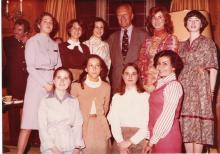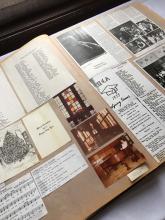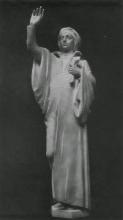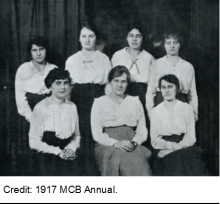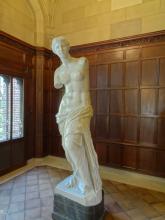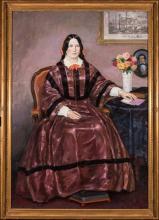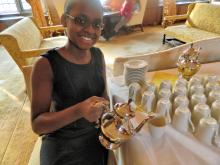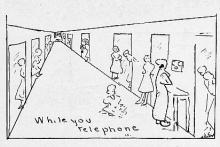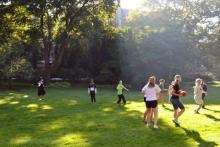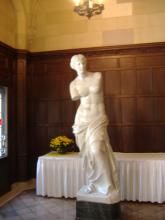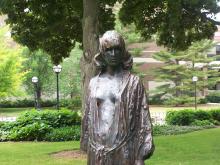History of Martha Cook Building
The Martha Cook Building’s First 100 Years by Kathy Graneggen Moberg and Catherine Walsh Davis and With Portia O’er the Door, edited by Pamela Sameck Wiedenbeck, published to commemorate Martha Cook’s 100th anniversary, are available on Amazon.com with the “look inside” feature to give you a feel for what they are like.
Each book costs $15. If you prefer not to order online, you may mail a check payable to Kathy Moberg, to 1256 Harwood Cir., Saline, MI 48176. Please add $4 shipping for each book. Profits for both volumes benefit MCB.
The Michigan Heritage Project, an online production of the Office of the U-M Vice President for Communications, is described as “a collection of multimedia stories about the people who have shaped, and been shaped by, one of the world’s great public universities.” This April, an article about President Gerald R. Ford’s 1977 visit to campus, titled "Professor Ford," was added to the archives and it includes an account of the sit-down dinner he attended at MCB.
Deb Day Jansen BS ’75, MS ’77
Shannon Meeks, Facilities Manager for the Martha Cook Building, mentioned to me that she wanted to clear out old, broken furniture from the storerooms on the 4th floor. Coincidentally, the House Board recently said that they would like to reopen the Sewing Room on the 4th floor and turn it into a student lounge, but it was overflowing with old furniture. I knew these two conversations were going to set me off on a real adventure, and we were going to find some treasures in those old storerooms.
Kathy Graneggen Moberg BA ’79
MCB’s elaborate Gothic portal was designed well before construction commenced in 1914 and applied as a logo to interior wood and stonework as well as on letterhead, dishes and silverware, the central niche remained empty for nearly three years. William W. Cook and his architects, York and Sawyer, began seriously discussing an appropriate figure to fill the space in the spring of 1917. Cook first suggested a bust of Minerva. That idea was diplomatically discouraged in favor of a full-length figure, preferably medieval to match the architectural style. By the end of June, Cook made his choice: Portia, the educated female character who masquerades as a lawyer in Shakespeare’s The Merchant of Venice.
By Catherine Walsh Davis BA’70, MM’76
In 1917, U-M celebrated its centennial, but the residence hall movement was in its nascence, with only Martha Cook, Helen Newberry, a few sororities, and League Houses (approved boarding houses) available to women. University-wide rules for women’s housing were still being developed, but those that existed were stringent by today’s standards and were meant to protect the reputations of the campus women.
By Kathy Graneggen Moberg BA ‘79
“The statue of Venus knows no age, no nationality and no locality. I thought it was cosmopolitan, belonging to all ages, all nations and localities. Venus, you know, according to the Greeks, was born of the foam of the wave, and hence was a child of nature. Her statue a finished product of nature, touched by the hand of man, is, like the hills, al-ways new, however old. You would not dare to say that she is not as young now as she was in the days of Troy. You dare not.”
The painting of William W. Cook’s mother, Martha Wolford Cook, did not grace the Red Room when MCB opened in September 1915, but was instead one of Cook’s early gifts.
If there has been one constant over MCB’s first 100 years, it is probably afternoon tea. But even this iconic element has undergone changes in practice almost from day one. It began as a daily routine when the Building opened and was meant to be a mechanism for teaching social skills to the young women of the Building. While it may have done that too, the young women of the Building chose to make the affair their own and determined it would be a respite from the cares of the academic world and would have “a cozy atmosphere that promotes closer understanding and fellowship,” as it was put in the 1924 Annual.
Our First Day At Martha Cook Building
In the fall of 1915, something came to pass to make history at the University of Michigan, and no one realized it more than the Ann Arbor taxi drivers. All traffic seemed directed toward Martha Cook Building, the magnificent new residence hall for women. It was quite overwhelming to have the driver ring the bell and leave us scared Freshmen bag and baggage, facing the great edifice with its unknown promises.
With the 100th anniversary approaching, the Martha Cook Building continues to look like the same dormitory York and Sawyer and the Hayden Company originally created and the one we all remember from our college days. The early 20th century era ambiance is intact, even as it meshes with 21st century student life. However, the beauty and functionality of MCB have continued to the present in part through careful and necessary changes which are a facet of good stewardship.
Those of us who lived at Martha Cook often think of the Building in terms of traditions and sometimes wince at the thought that the Building or, more precisely, the life style at MCB might differ from the halcyon days we remember. But, as we have discovered, change itself is a Martha Cook tradition.
All of us Cookies, past and present, take Venus Down the Hall for granted. Standing ever vigilant, watching our mischievous activities in silence, she endures all the decorations and attires that over 90 years of students have imposed on her.
The Martha Cook Building opened its doors for the first time in September 1915. Martha Cook — described as the most beautiful college dormitory in the United States — has been home to thousands of women.


